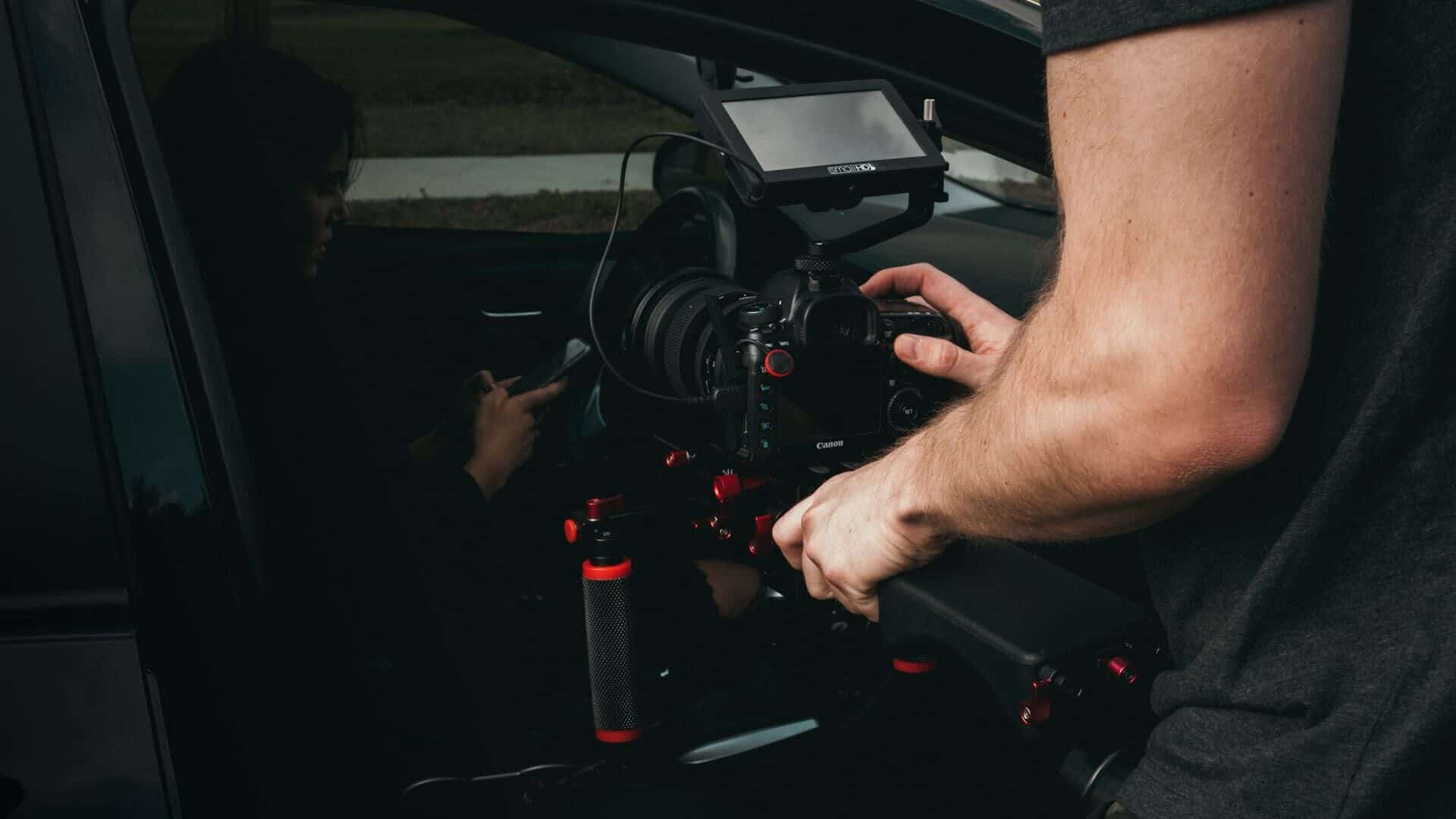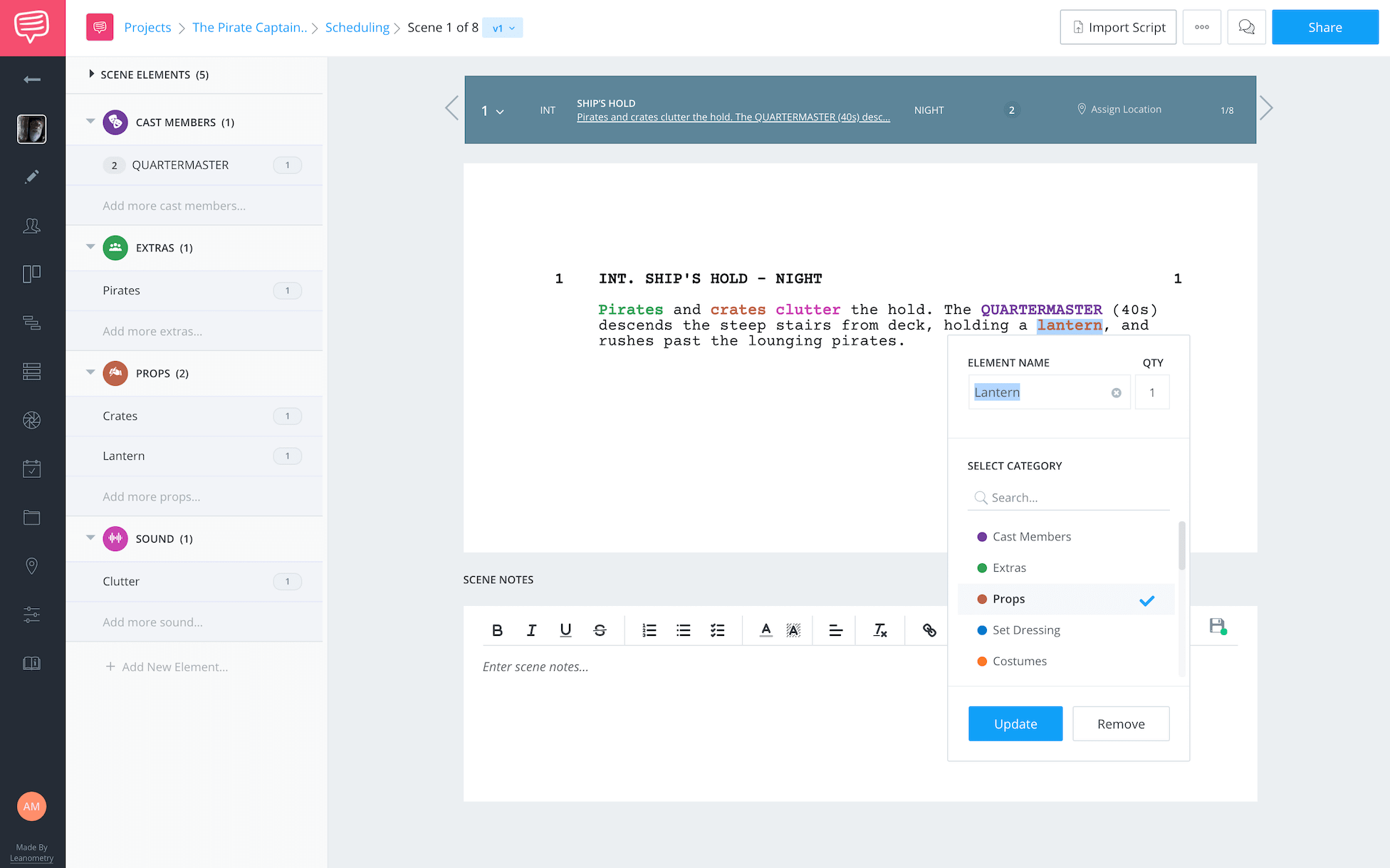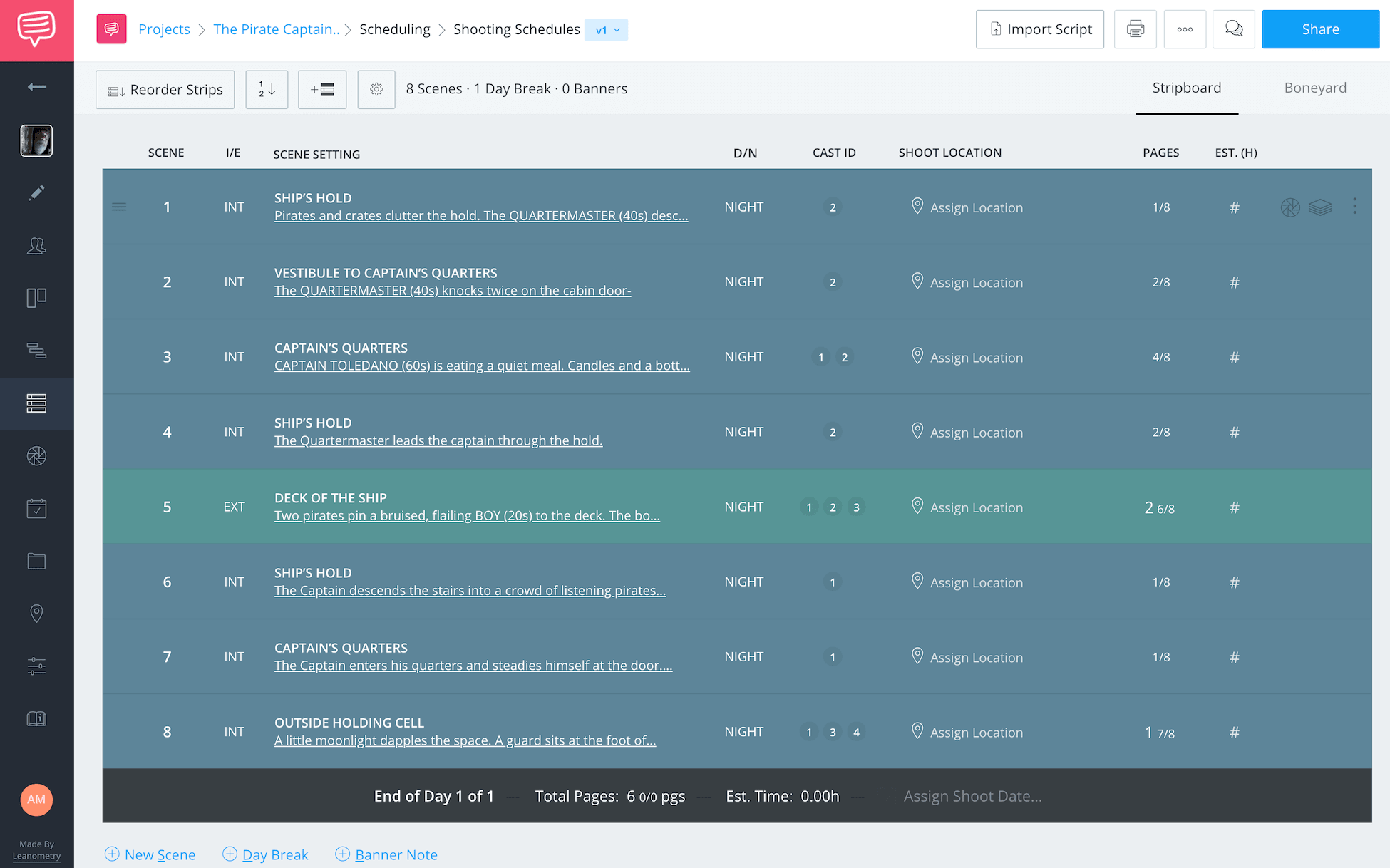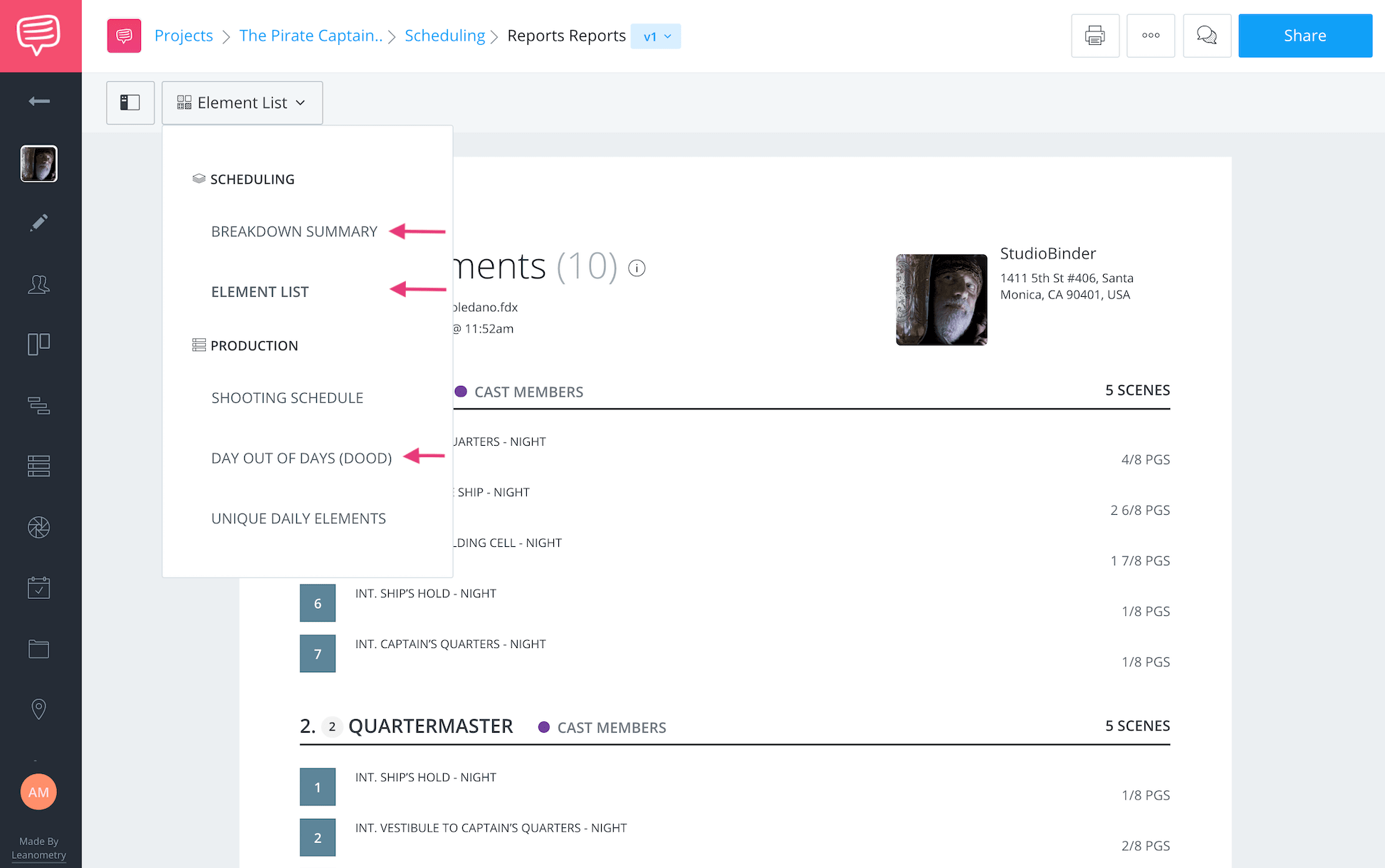So you’re financed and ready for pre production. But with so many steps in the film production cycle (casting, shot listing, insurance), how do you get organized? Where do you start? Never fear. Pre production is a linear process. You just need to check off the boxes in the right order.
In today’s post I’ll detail how to make a short film like a veteran filmmaker: with practical efficiency. I’ll focus on the three phases of pre production that worked to make my short film, The Pirate Captain Toledano. I’ll share why the steps have to happen in this order. And even though I’ll tell you how to make a short film, these pre production principles apply just as readily to feature and video content production as well.
1
When Does Pre Production Begin?
First Thing's First
PLANNING A FILM SHOOT
When does pre production begin?
Most filmmakers I know have a clear idea of when pre production ends. When cameras roll and production gets going, that’s a good sign that pre production is over. But what is the proper pre production definition?
Some filmmakers use the term “pre production” loosely. They get an idea for a film and — whammo — they’re in “pre production.”
Often, this person is really in the development phase. That means they’re raising money. Or they’re planning a film script (or working on it), or packaging talent to inspire investors.
PRE PRODUCTION DEFINITION
What is pre production?
Pre production is at the start, when key resources such as script, financing, and talent are in place. The pre production phase, coming after development and preceding production, addresses everything that must happen before filming begins. The film has been greenlit, it’s “go-time,” and final preparations take place.
What is pre production?
- Breaking down the script
- Shot listing and/or storyboarding
- Scheduling production
- Hiring cast and crew
- Securing shoot locations
- Reading through the shooting script with the entire team
My preferred pre production definition requires that all resources are in place. That means script, money, and, in some cases, above-the-line talent.
Only with these secured are you truly in pre production.
2
How much budget to start?
Know Ahead of Time
HOW TO MAKE A SHORT FILM
How much budget is needed to start?
Pre production should begin when you have enough money to get your film all the way through post production.
I’ve seen too many features and shorts begin pre production before fundraising is done. The results can be catastrophic.
Trust me, don’t take your eye off the fundraising ball.
As with all events in your film production cycle, the sequence matters. Don’t jump the gun!
Keep in mind that during pre production, you’ll design and plan every step of making your film. In the production pipeline — development, pre production, production, post production, and distribution — pre production often involves the most heavy lifting.
It’s critical to recognize that every phase in the film production cycle comes with unique responsibilities and challenges.
Without getting overwhelmed, you need to know that as big a deal as pre production is, it’s only one piece in a much larger puzzle.
If you’re using production management software like StudioBinder, you can organize and execute every step of your production workflow in one place. From development through distribution, all of your contacts, calendars, call sheets, and tasks will be cloud-based. They’ll be easy to share, and you can make updates on-the-fly.
Better to think about these things in your planning stages instead of during the mad-dash of production.
3
Three stages of pre-production
A primer
FILM PRODUCTION FOCUS
A primer on the three stages of pre production
Pre production is where you build the foundation of your film production cycle.
Here, you’ll take care of all of the set-up work, including establishing a production company, and securing talent, locations, and equipment.
I’ve broken pre production into three primary types of preparation. As we go on, I’ll use construction metaphors to clarify what this all means.
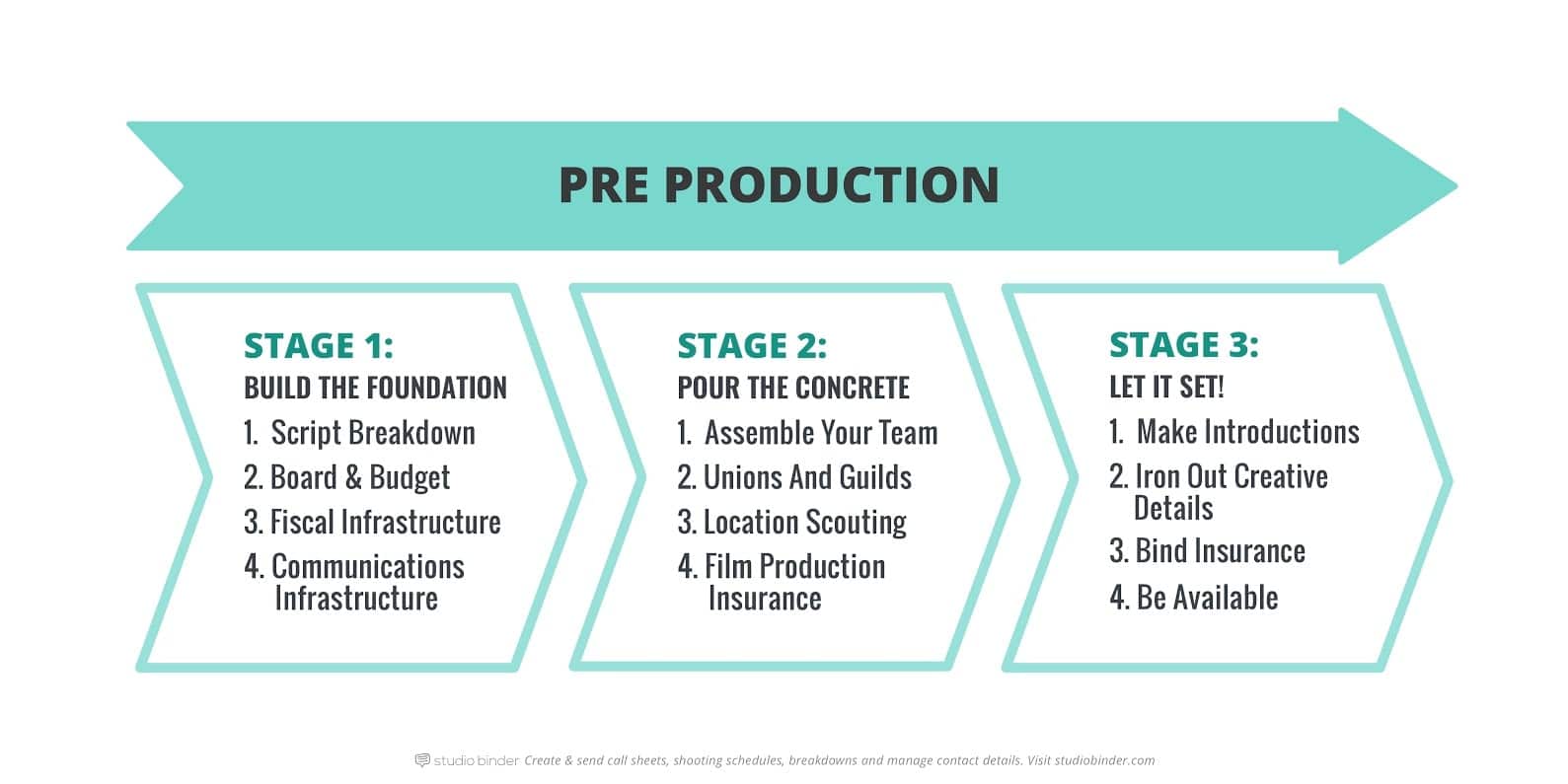
Any production goes through three “construction” stages.
Construction metaphors seem appropriate. After all, construction, production, manufacturing — it’s all a matter of starting with an idea and taking the necessary steps to bring about creation.
4
Build the foundation
Stage One
PRE PRODUCTION CHECKLIST
Stage One: Build the foundation
When builders build a house, their first step is to dig out the ground to pour the foundation. So too in your film production cycle. During this stage of pre production, you’ll need to define your project parameters.
Maybe it’s a critical location or important talent might only be available until a certain date. To build your foundation, you will start on these tasks right away.
First things first. Don’t forget to make a production calendar.
I prefer to use film production software like StudioBinder to handle scheduling. StudioBinder allows me to layer my production phases.
It’s easier to schedule your film because the application bundles your pre production tasks (calendar, shot list, storyboard, call sheets) in one place. It also lets you communicate with your collaborators as you go.
This is great because it’s possible that you’ll have some key personnel involved at this stage.
Maybe your director is already attached? Maybe you’re working with a line producer that helped you put together the development materials?
You need to stay connected, because your team is about to get much bigger!
FILM PLANNING TEMPLATE
4.1. Script breakdown
If this wasn’t done thoroughly during development, now’s the time to do a detailed breakdown of your screenplay.
There are many film planning templates out there. But I suggest breaking them down in production management software like StudioBinder.
Here your breakdown data feeds your reports. The screenplay elements you tag will be listed and categorized for you — in customizable formats.
We can use the software to break down the first scene in my short. Notice how easy it is to identify and tag the key elements.
These will become very useful, starting with your next step.
Related Posts
VIDEO CONTENT PRODUCTION
4.2. Board and budget
Your stripboard, which is your shooting schedule, defines the parameters of your production. It will present important budgetary data. This includes how many days you’ll shoot in each location, and how long will each actor work. This will help you avoid any shooting schedule nightmares.
And StudioBinder has you covered with all of it.
Let's take a quick look at the StudioBinder's stripboard for the short film so we have a better visual going forward.
With your stripboard and production reports you’ll have enough data to make a detailed budget.
Click below and explore the software's features. On the left, you'll see you have access to any report generated from your stripboard's info to help you budget more efficiently.
With this you can determine how much things will cost and how much you’re willing or able to spend.
Things change often at this stage, so an intuitive stripboard interface that easily lets you make updates and adjustments is essential.
This is why the order of pre production matters!
You can’t hire your crew until you know how much you can offer. And you can’t know that until you finish the budget.
Related Posts
PLANNING A SHORT FILM
4.3. Fiscal infrastructure
Construction sites need power taps to stay running, but you’ll need financial infrastructure in place to do the same.
If your short film is big enough to warrant its own bank account, set it up now. Otherwise, a couple new checkbooks for your current bank account will suffice.
If electronic cast and crew payroll is how you roll, set up your Venmo, Google Wallet, or Facebook Messenger payment accounts now.
To know how to make a short film on budget, you must account for all expenses. So, at the very least, make a budget sheet listing all expenses with a grand total.
If you maintain it properly you’ll always know how much you’ve spent — and how much is left.
PRE PRODUCTION DEFINITION IN ACTION
4.4. Communications infrastructure
Make sure that your project’s communications infrastructure is in place. If you want to run the project from a separate email address, set it up now.
It doesn’t hurt to set up social media accounts now, too. You don’t need to use them heavily. Just post enough to build a small buzz around your project before the distribution game begins.
5
Pour the concrete
Stage Two
CONTINUING THE FILM PRODUCTION CYCLE
5. Stage Two: Pour the concrete
In our analogy, pouring concrete is like spending money. You’ve dug out the foundation, so now you know how much you need to pour.
ADVANCED VIDEO CONTENT PRODUCTION
5.1. Assemble your team
In this phase of the film production cycle, your job is primarily to hire people. You should hire your director first (if the director isn’t already attached). Your director will be involved in casting, and in selecting department heads and possibly some additional crew.
From there, hire your department heads, and work with them to hire their teams. You’ll use your schedule and budget as a guide. Be fierce about it. Don’t offer more than you’ll be able to afford. Tweak your budget as you negotiate deals to keep track.
To know how to make a short film, you must master the hiring process.
Call on all your contacts.
Use professional job boards like ProductionBeast.
Ask your hires to recommend other crew for their departments.
Take those recommendations as much as possible because often they tell you more than a resume or demo reel.
HOW TO PLAN A SHORT FILM THE RIGHT WAY
5.2. Unions and guilds
Unions and guilds will come up when you first learn how to make a short film. Although you probably won’t need them for your crew, you may need actors who are SAG/AFTRA members.
If you are planning a film shoot with union actors, start the paperwork as early as possible.
The Screen Actors Guild requires you to submit certain materials with your initial application. These include a budget top sheet and production schedules. These won’t be ready until the end of stage one of pre production. So you won’t submit your initial SAG paperwork until the beginning of stage two.
It can take several weeks for the Guild to turn your application around, so even if you don’t get it done right away, don’t wait to the last minute!
LEARN HOW TO PLAN A SHORT FILM
5.3. Location scouting
This is your opportunity to scout for filming locations. Go alone, go with your director and cinematographer, or send a location scout (depending on budget and resources).
Once you find locations that you like, begin the process of getting permission from the location owners to shoot on their property.
Secure permits from the agencies who cover the area you’re shooting. In some cases, they may even help you with the location scouting, or recommend lower-cost location options.
Several years ago, I produced a short web commercial that required a city park. Parks in Los Angeles are notoriously expensive. They have permit fees, park service fees, and supervision requirements that are prohibitive for smaller-scale productions. I contacted film commissions in surrounding counties, and received a lot of help from the folks in Riverside County.
They had a much less expensive permit (it was free!) and referred me to parks within the county that would also be free of location fees.
Film offices, film commissions, and permitting offices can all be very helpful to you if you don’t wait until the last minute to get in touch with them.
Related Posts
FILM PRODUCTION INSURANCE OVERVIEW
5.4. Film production insurance
You probably won’t bind your insurance policy just yet, but it’s a good time to start calling around. Get quotes from different insurance providers. Give yourself enough time to navigate potential insurance ‘hazards’ that would affect your policy or rate.
It’s good to establish a relationship with your insurer, too.
On my short, The Pirate Captain Toledano, I went with an insurance company that I had known and worked with before.
The production was more complicated than my earlier projects. We shot on tall anchored ships and required film production insurance that protected us over water. This posed a problem with their jurisdictions. Because we shot on land and over water, we were required to get two insurance policies. One policy covered us on land, and another that covered us over water.
If I hadn’t contacted my insurance company early enough, we would have never been able to get out of the insurance maze in time for the start of production!
6
Let it set
Stage Three
FILM PLANNING TEMPLATE PHASE THREE
6. Stage Three: Let it set!
After you pour your concrete, you can’t build on it right away. Nor should you start production immediately after you’ve secured your resources.
In order to do the most effective job, your team needs time to prepare.
PLANNING A FILM SHOOT WITH YOUR TEAM
6.1. Make introductions
Stage three of pre production typically begins with a full-team production meeting or a read-through of the script.
Here, everyone meets for the first time. Many of your creative details will be discussed and ironed out too. Which brings us to the next item.
FILM PLANNING TEMPLATE INSIGHTS
6.2. Iron out creative details
Your director will be very busy during stage three of pre production. He or she will rehearse with actors, and make the shot list with the cinematographer. They may also review props, wardrobe, and other creative elements.
During stage three, you’ll work with your team to secure the necessary equipment and supplies for your shoot. The most common challenge here is when creative ideas come into conflict with the limits of your budget.
Take a deep breath and hold your ground. Everyone is trying to make the best movie that they can. And so are you. If an unexpected expense becomes necessary, hopefully you’ve budgeted a contingency from which you can draw some extra funds.
RELATED POSTS
PRE PRODUCTION DEFINITION ESSENTIALS
6.3. Bind insurance
Even though you’ve made it all the way to stage three, don’t expect to rest on your laurels. You’ve got insurance policies to bind, final guild paperwork to sign, permits to finish securing, and all the other little details to lock into place.
Your own team will be hard at work at this stage. They will prepare starting paperwork for the cast and crew, and call sheets for the first day of production.
PLANNING A FILM SCRIPT FOR PRODUCTION
6.4. Be available
Your first day of production approaches, so the pressure is mounting. Take care of yourself, and take care of your team. Know how to make a short film that doesn’t burn everyone out before it starts.
7
For the producer
It Gets Easier
UNDERSTANDING HOW TO MAKE A SHORT FILM
7. For the producer, it gets easier
When you’re in pre production it’ll feel a bit chaotic at times. Prepare to juggle many things simultaneously. But if you stick with your workflow you’ll stay organized.
The silver lining is if you know how to plan a short film properly, the actual production of your short film should be relatively easy.
There are still things that you know better than anyone else about your production. Inevitably challenges (like difficult talent or crew) will emerge. But having a thorough pre production will help you navigate around them.
But you’ll have that knowledge, and the ability to implement it, only if your pre production was thoughtful and thorough.
For further reading, check out my deeper dive into the phases of pre production.
Remember, these principles apply to shorts, features and video content production. And if you have any questions, please don’t hesitate to reach out to me on Twitter and Facebook!
UP NEXT
Pre production: step-by-step
Now that you understand the three stages of pre-production, let's refine our approach. We’re learning how to plan a short film, right? It’s time to get as detailed as possible.
You’ll want to do everything you can to prepare as thoroughly as possible for your shoot. That means taking it step-by-step. Roll up your sleeves and get deeper into pre production workflow.
